

建筑及景观设计 三文建筑
项目地点 河南焦作
建成时间 2021年5月
规划/建筑面积 8.5公顷(景观);820平方米(豫北民居展厅);108平方米(便民服务点)
背景与原貌
美学引领的乡村振兴与“三无”普通乡村
修武县位于河南省焦作市,属于豫北地区。近年来,修武县大力倡导美学引领的乡村振兴路径,取得了非常显著的成果。
Xiuwu County is located in Jiaozuo City, Henan Province, and belongs to the north of Henan. In recent years, Xiuwu County has vigorously advocated the path of rural revitalization led by aesthetics, and has achieved remarkable results.
宰湾村属于七贤镇,是典型的平原村。村庄为1960年代整村搬迁而成,空间结构呈板正的鱼骨形,没有历史建筑。村庄缺乏风景,西侧紧靠国道,东侧的丘陵属于军事用地,不能进入。村庄已没有耕地,也没有集体经济,村民或在云台山景区从事服务业,或在附近的矿山务工,并不贫困,但从长远看缺乏内生动力。
Zaiwan Village is a typical plain village, which belongs to Qixian Town. The whole village was relocated in 1960s, and the spatial structure was in the shape of fish bone, without historical buildings. In lack of landscape, the village's west side is close to the national highway, and the hills on the East belong to military zone forbidden from entering. The village has no cultivated land or collective economy. Villagers are not poor who work either in service industry at the Yuntai Mountain scenic spot or in nearby mines, but they lack endogenous power in the long run.

面对这样一个“三无”(无风景,无风貌,无产业)村庄,应该如何对其进行提升,既不落入简单涂涂抹抹的俗套,又要在有限造价内给予村庄新的个性是个难题。
Facing such a "three-no" village (no scenery, no style and features, no industry), how to improve it is a difficult problem: not only not to conform to conventional pattern of simple painting and plastering, but also to give the village new personality within the limited cost.


破题
改革开放40年豫北民居活态博物馆
建筑师发现村中民居断代特征清晰,并以一种“切片”的形式存在。此外,又夹杂着大量自发建造的痕迹,如彩钢棚、光伏板等,这使村落显得混乱但真实,是近40年豫北民居变迁的一份活态标本。如果从更深的层次解读,还会发现这些印记还反映了改革开放后,人民对美好生活的自发追求,以及党和政府改善群众生活的实际行动。
The architect found that the characteristics of division of historic periods of the village houses were clear and existed in the form of "slicing". In addition, there were a lot of traces of spontaneous construction, such as colored steel shed and photovoltaic board, which makes the village appear chaotic but real, which is a living specimen of the changes of the residential buildings in Northern Henan in recent 40 years. If read from a deeper level, you will find that these marks also reflect the people's spontaneous pursuit of a better life after the Reform and Opening-up, and the actual actions of the party and the government to improve the people's life.
本项目正是希望通过美学设计,对这种样本式建构进行梳理、放大,使之清晰化、系统化。
This project just hopes to sort out and enlarge the sample construction through aesthetic design, so as to make it clear and systematic.


规划设计思路
“点—线—面”的结构和实施路径
规划设计分为几个步骤:首先保留村庄肌理和自建痕迹,形成活态博物馆的基本面;然后对环境卫生、村庄道路、房前屋后、村庄照明等进行整体提升,为村民提供更好的生活条件;再后,打造精品路线和空间节点。
The planning and design is divided into several steps: first, the village texture and self-built traces are preserved to form the fundamental plane of the living museum. Then, the environmental health, village roads, spaces before and behind the houses, village lighting and so on are promoted as a whole, so as to provide better living conditions for the villagers. After that, a boutique visiting route and space nodes are created.


对村庄基础设施的提升包括:道路白改黑(将水泥路面改为沥青路面),增加绿化,弱电入地,用光伏路灯替换原有路灯,治理裸房墙面,下水管道疏通、隐藏等。
The improvement of village infrastructure includes: white cement pavements changed to black asphalt pavement, greening increased, weak current cables buried into ground, original street lamps replaced with photovoltaic ones, walls of bare houses treated, and the sewer pipes dredged and hidden.


精品线路就是一条“时间轴线”,它把宰湾村近40年的建设行为串联起来。设计对路面、墙面等位置进行艺术化处理,增加街道家具和游戏装置等,使之成为村民公共生活的主要场地。
The boutique visiting route is a "time axis", which connects the construction behaviors of Zaiwan Village in the past 40 years. For the roads and walls, the design applies artistic treatment. And street furniture and game devices are added, so that it becomes the main site for villagers' public life.


设计在重要位置上增设节点,包括:豫北民居展厅、村标、卫生院立面改造,“椿暖花开”艺术装置、“有囍有鱼”广场等。它们与村庄南段村委会形成一个节点序列。
In the important positions, space nodes are added, including: Gallery of North Henan Folk Residence, village marker, elevation transformation of the village health center, art device of Spring Blossoms, Square of Double Happiness and Pisces, etc. They form a node sequence with the village committee in the southern part.

叙事性景观和公共艺术
用公共艺术和景观手段提升空间品质,并着重叙事性表达
新设计的景观和公共艺术带有强烈的叙事性,它为阅读这个特殊的博物馆提供了线索,具体分为:路面、墙面、装置、街道家具四类。
The new designed landscape and public art have strong narrative characteristics, which provide clues for reading this special museum and can be divided into four categories: pavement, wall, installation and street furniture.

路面,南北主街以三色条带图形为主线,黄色代表燃气管道、绿色代表弱电线路,蓝色代表下水管线,再配以说明文字,共同建构了主街路面的艺术叙事。设计缘起为多次管线铺设在路面上留下的“疤痕”,建筑师认为这些疤痕记录了建设的历程,可转化为图形表达,形成一个特殊文本。街道家具既具有功能性,也是路面叙事的延续,同样呈蓝、绿、黄三色,并与地面色条带相互串联。
The main north-south street is composed of three color strip graphics, yellow for gas pipeline, green for weak current line and blue for sewer pipeline, and together with explanatory text, the artistic narration of main street pavement is constructed. The design is based on the following: the "scars" left by the pipelines laying on the pavement for many times. The architect believe that these scars record the construction process, and can be transformed into graphic expression and form a special text. Street furniture is not only functional, but also the continuation of the pavement narrative, which is also in blue, green and yellow, and is connected with the ground color strips.
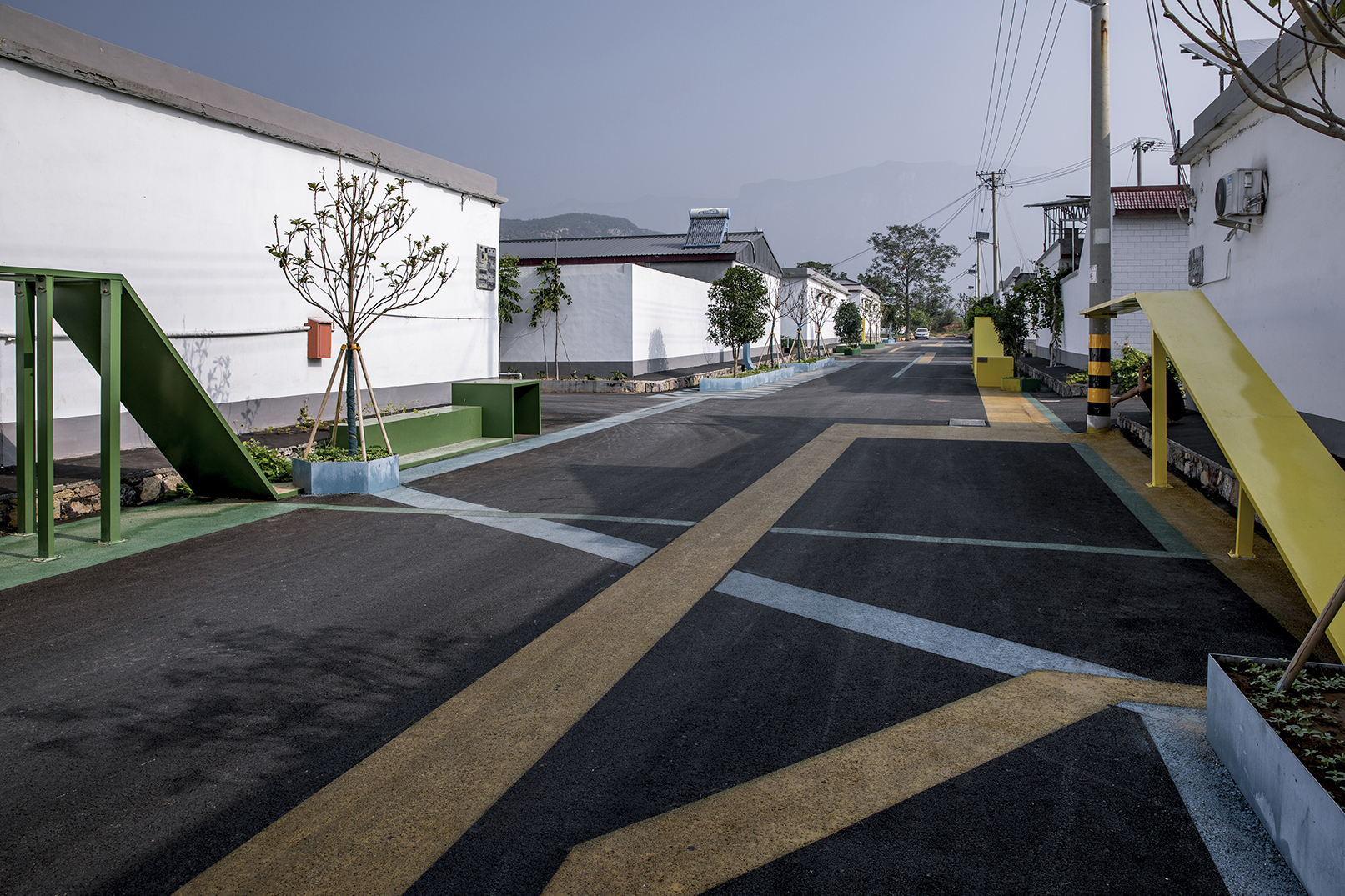
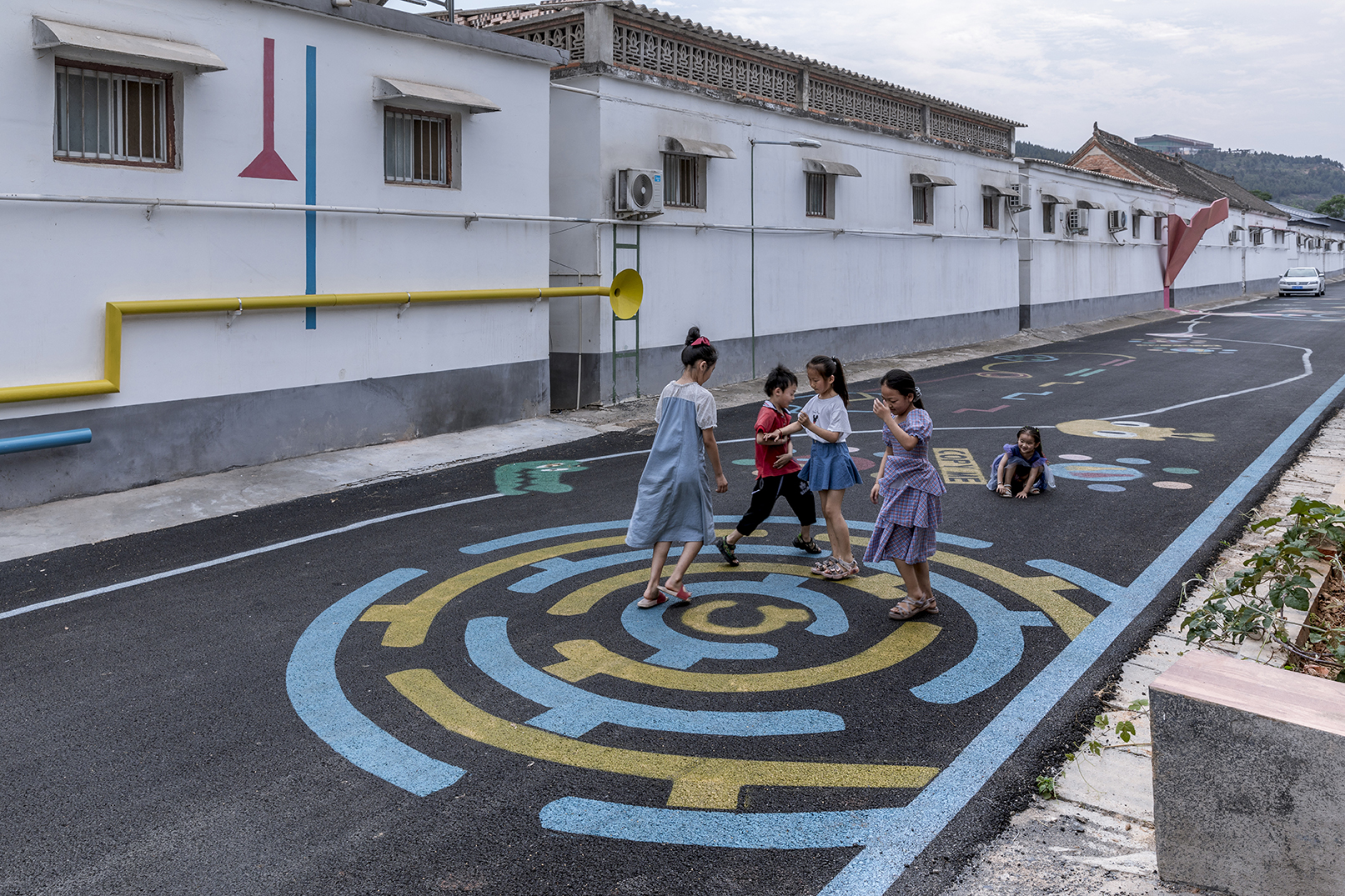
街巷路面相对轻松,选用儿童画的形式,也有孩子们喜欢的游戏图案,如跳房子、迷宫等。它们为村中儿童提供了游戏场所。
The streets and lanes are relatively relaxed, and children's paintings are selected, and there are also games loved by children, such as hopscotch and mazes. They provide a place for children in the village.


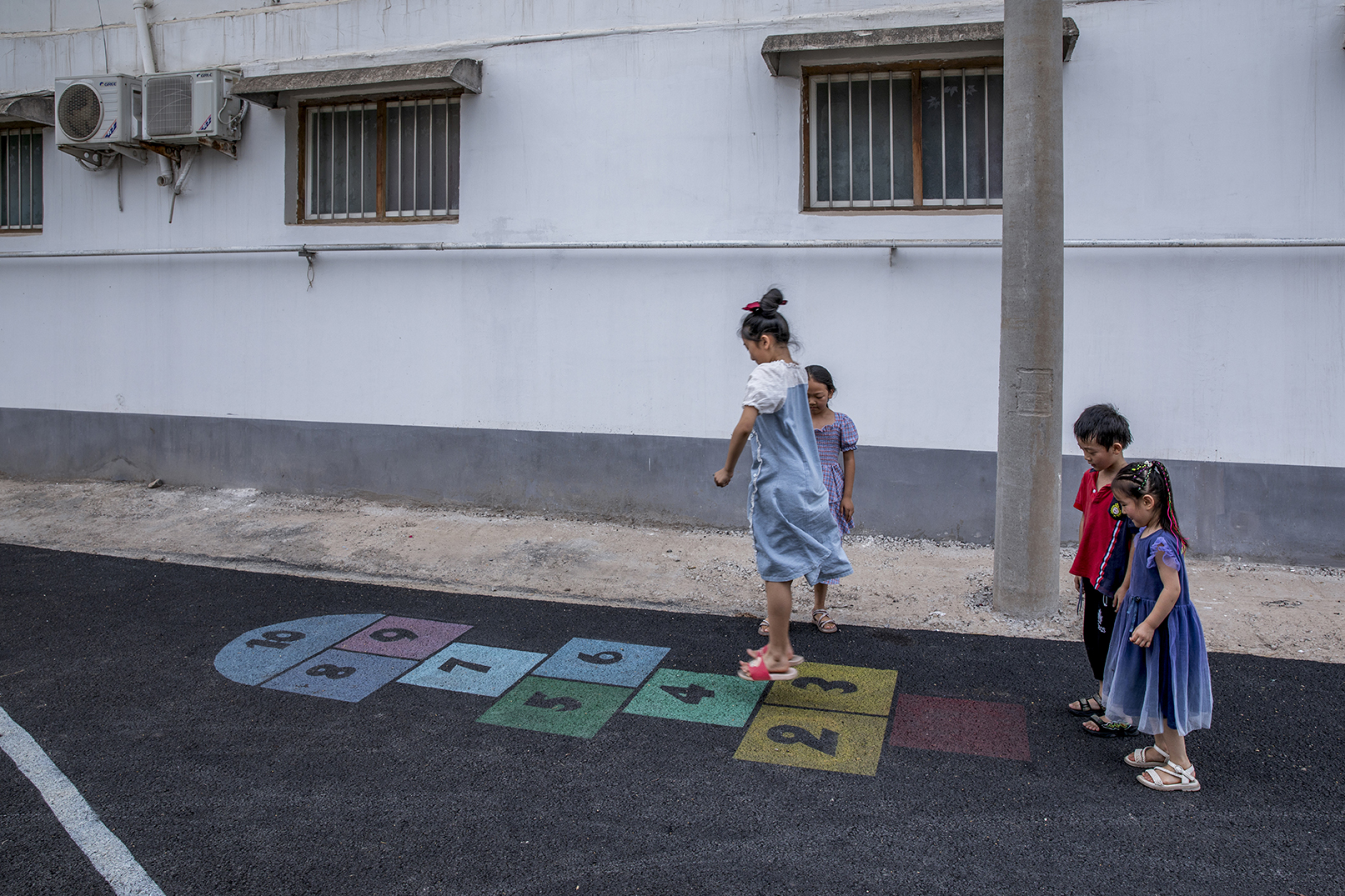
墙面的墙绘也强调艺术叙事和趣味性。如关于路灯的墙绘:建筑师发现村庄中有多处从建筑外墙中伸出来的路灯。于是在相应位置绘制了灯光和灯杆的主题,暗示增设建筑保温,遮蔽灯杆的事件。
The paintings on walls also emphasize artistic narration and interest. For example, as for the wall drawing of street lights, the architect found that there are many street lights in the village that protruded from the external walls of the building. So the theme of light and pole is drawn in corresponding position, suggesting the event of building insulation was added to cover light pole.


设计在主街的中间区域安置一组游戏装置,没有采用高科技和昂贵材料,而是一组简单的管道和传音筒。它是村庄基础设施管线的延续和艺术化表现。新装置与墙面的墙绘、原有管线及地绘的色带图案相连,形成墙地连续的三维空间叙事。
In the middle of the main street, a set of game devices are installed. Instead of high-tech and expensive materials, it's been a simple set of pipes and microphones. It is the continuation and artistic expression of the village infrastructure pipelines. The new device is connected with wall drawings, original pipelines and color belt patterns painted on the ground form the three-dimensional space narrative of wall and ground.

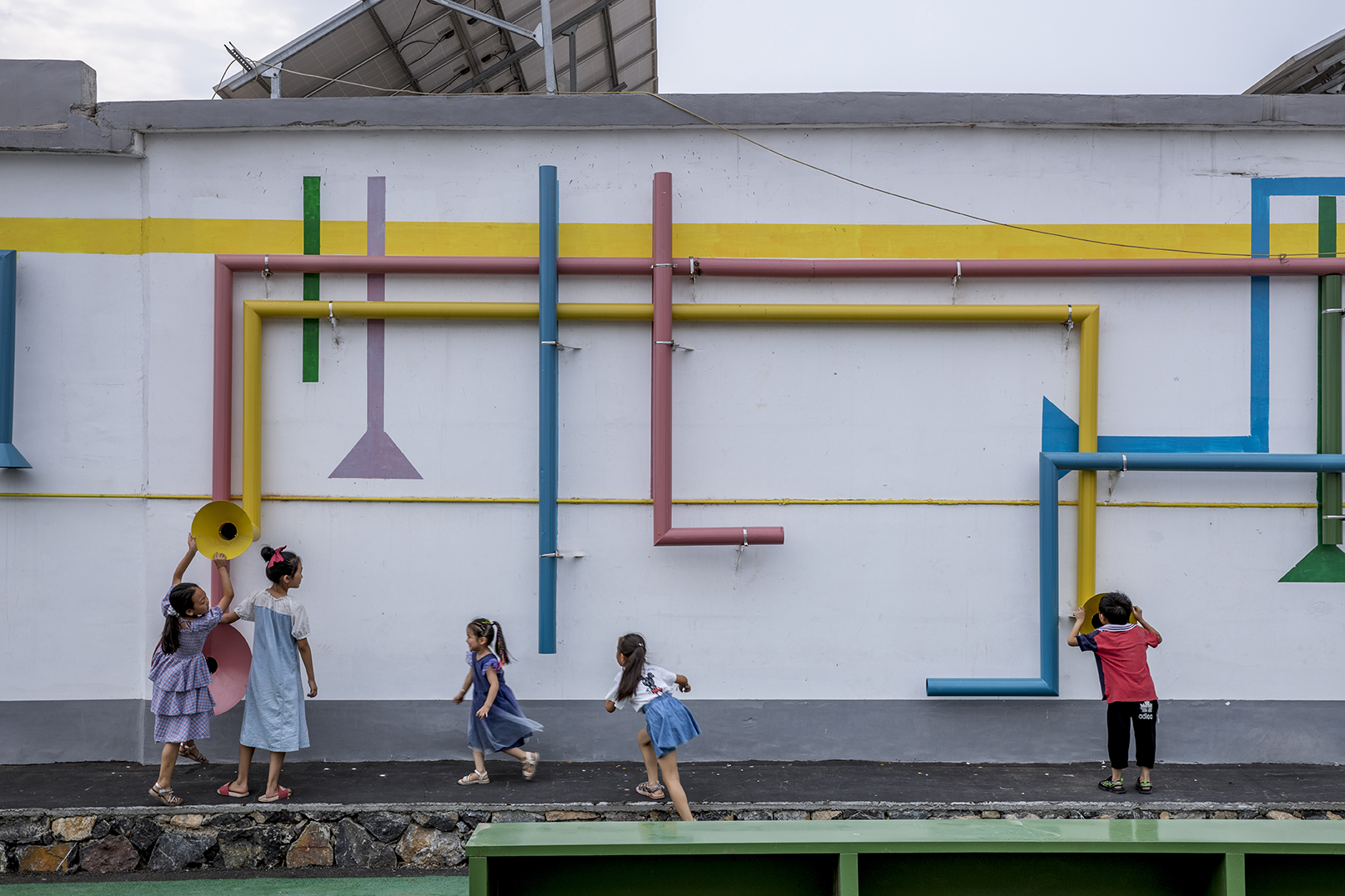

空间节点
整体提升中的重音,公共活动的载体
在村里环境整体提升的前提下,建筑师也在重要位置设置了节点,这些空间节点也是未来宰湾村公共活动的主要载体。
Under the premise of the overall improvement of the village environment, the architect also set up nodes in important positions, which are also the main carriers of the village public activities in the future.
村标,位于宰湾村西侧,卫生院和豫北民居展厅之间,从国道上便可以看到。建筑师将村标设计成一组高低不等的柱状体,它代表宰湾村的发展蒸蒸日上,节节攀升。在柱体上是村庄大事记,如建村、建校等重要时刻。
The village marker, located in the west side of Zaiwan Village, between the health center and the Gallery of the North Henan Folk Residence, can be seen from the national highway. The architect designed the village marker into a group of columns with different heights, which represents the development of Zaiwan Village is booming and rising. On the columns is a chronicle of events of the village, such as the founding of village, school building and other important moments.



豫北民居展厅由两个院落改造而成,建筑师将院落打通,保留了场地中的三栋老建筑,作为60年代民居的代表。在此基础上,重新梳理流线,增加新建筑、入口玄关、连廊和户外休憩空间。
The Gallery is transformed from two courtyards. The architect opened the courtyard and reserved three old buildings in the site, as the representatives of the folk residence in 1960s. On this basis, the streamline is re-sorted out and new buildings, entrance porches, corridors and outdoor rest space are added.



建筑临街的外立面,采用红砖和黑色钢板组合的语言,红砖与旁边的60年代院落材料保持一致,金属板提示了时代性。立面强调水平方向的线条,平实不闹,但在细部利用砖的可塑性形成了设计的变化。
The facade of the building is in the language of combination of red brick and black steel plate. The red brick is consistent with the courtyard materials of the 1960s nearby, and the metal plate indicates the contemporaneity. The elevation emphasizes the horizontal lines, which are flat and not noisy, but the plasticity of bricks is used in detail to form changes.




主入口位于西侧院落,观众需要迂回的进入。设计保留了正房和厢房,进行适当修缮,作为展厅使用。东院保留了北侧的正房,在南侧增加一座新建筑,它将作为咖啡厅、茶室和文创产品展示售卖的空间。
The main entrance is located in the courtyard on the west side, where the audience needs to enter circuitously. The main room and wing-rooms are reserved with proper repair and use as exhibition hall. The main room on the north side in the east courtyard is retained, with a new building added to the south. Its functions are coffee bar, tea room and cultural and creative products display and sale.





新旧建筑呈对视的状态,并由西侧的廊道相连。老建筑保持原貌的夯土,新建筑为红砖,交通空间为黑色钢板,建筑师有意让一些位置形成缝隙,一方面避免了新旧材料之间的冲突,另一方面也强化了光线在空间中的戏剧性作用。
The old and new buildings are in a state of opposite view and connected by the corridor on the west side. The old buildings keep the original rammed earth while the new buildings are red-bricked, and the traffic space is of black steel plates. The architect intends to make some positions form gaps. On the one hand, the conflict between the old and the new materials is avoided, and on the other hand, the dramatic role of light in space is strengthened.






在室内布局上,老建筑作为展厅使用,原始空间格局被保留,并适当恢复历史面貌,再现豫北地区的室内生活场景。新建筑作为休闲和售卖功能,为参观者提供休息交流的空间。
In the interior layout, the old buildings are used as exhibition halls, the original space pattern is preserved, and the historical features are properly restored to reproduce the indoor life scenes in Northern Henan. As a leisure and sales function, the new building provides visitors with space for rest and exchange.
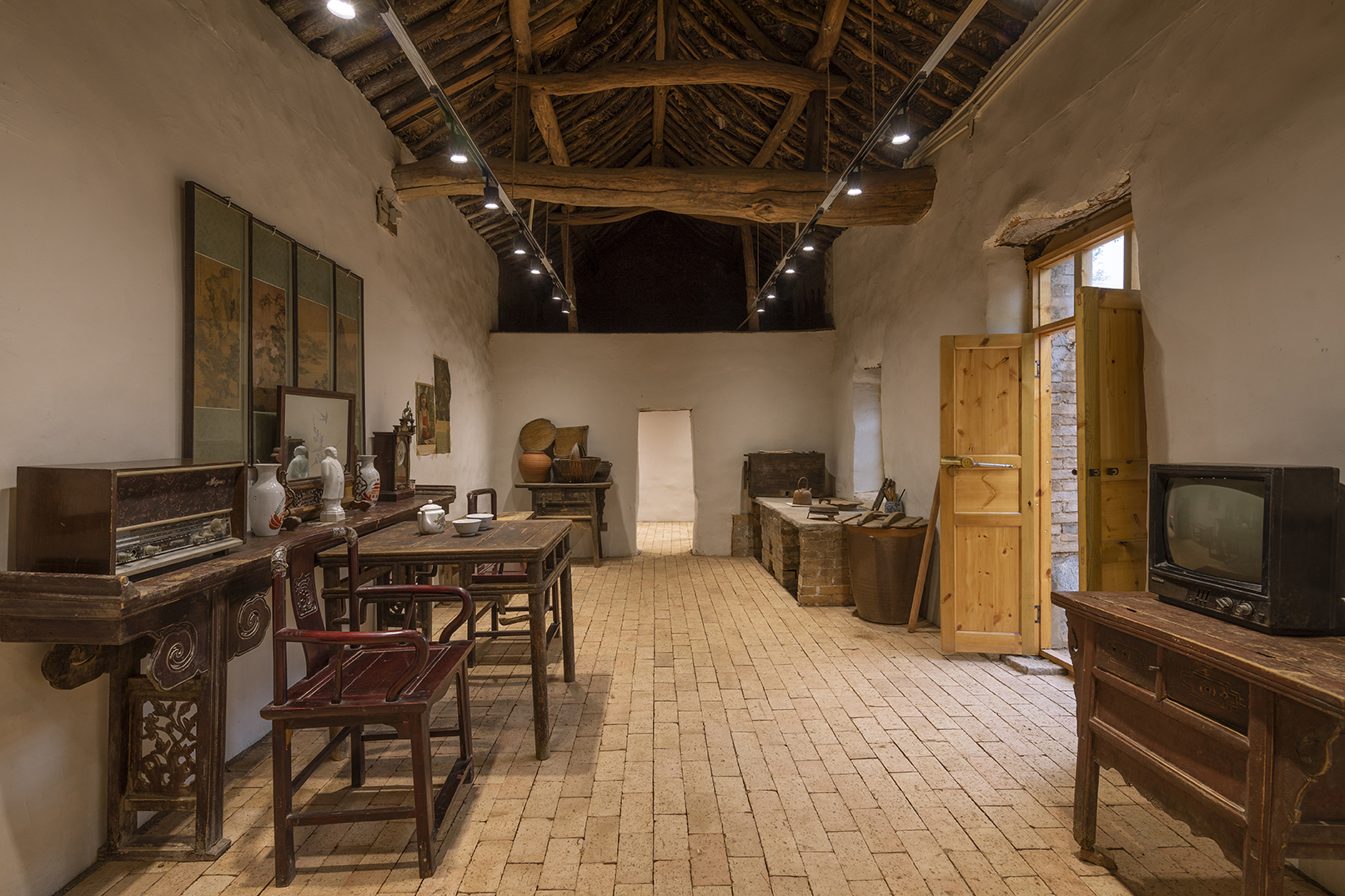

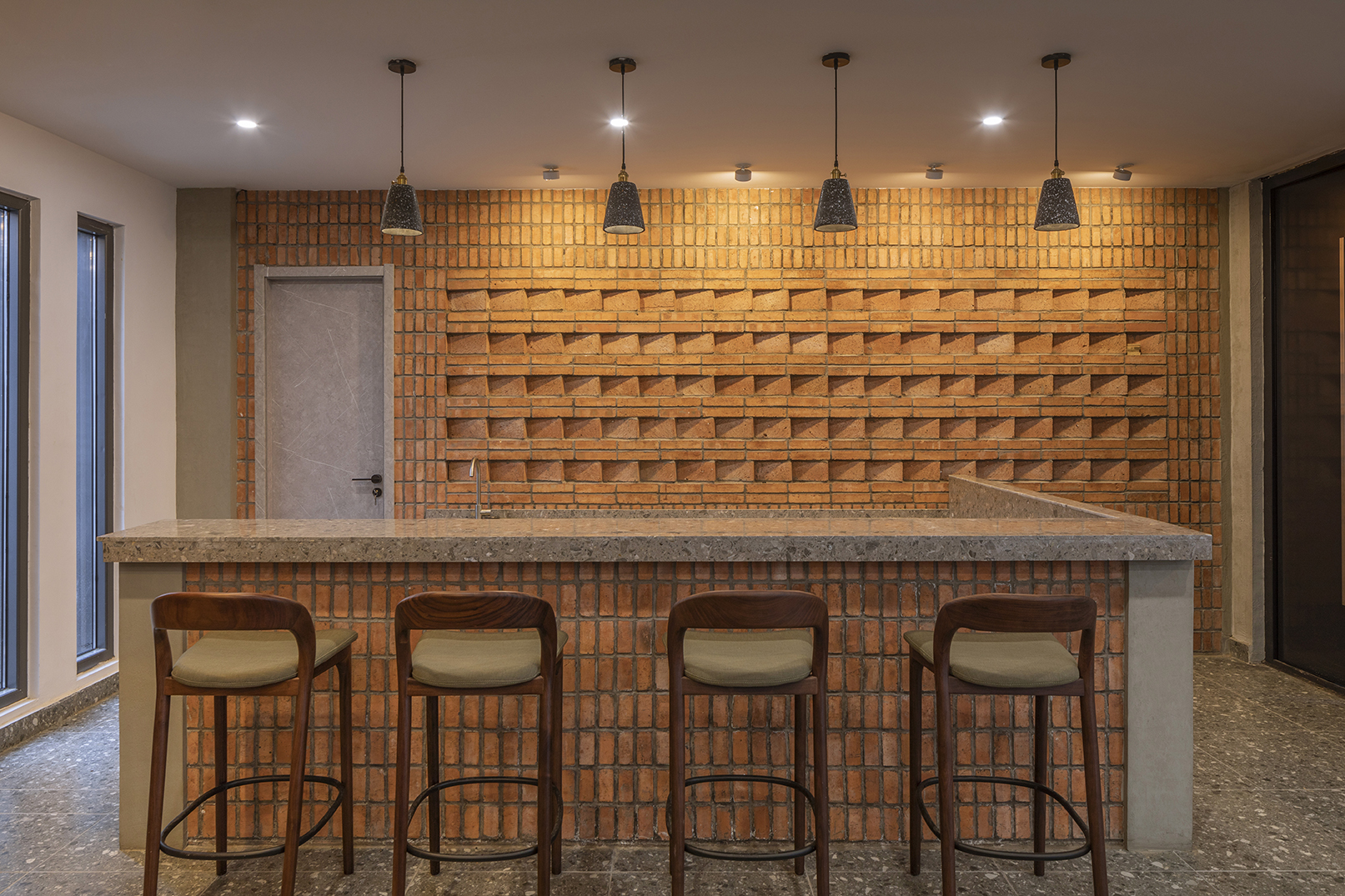
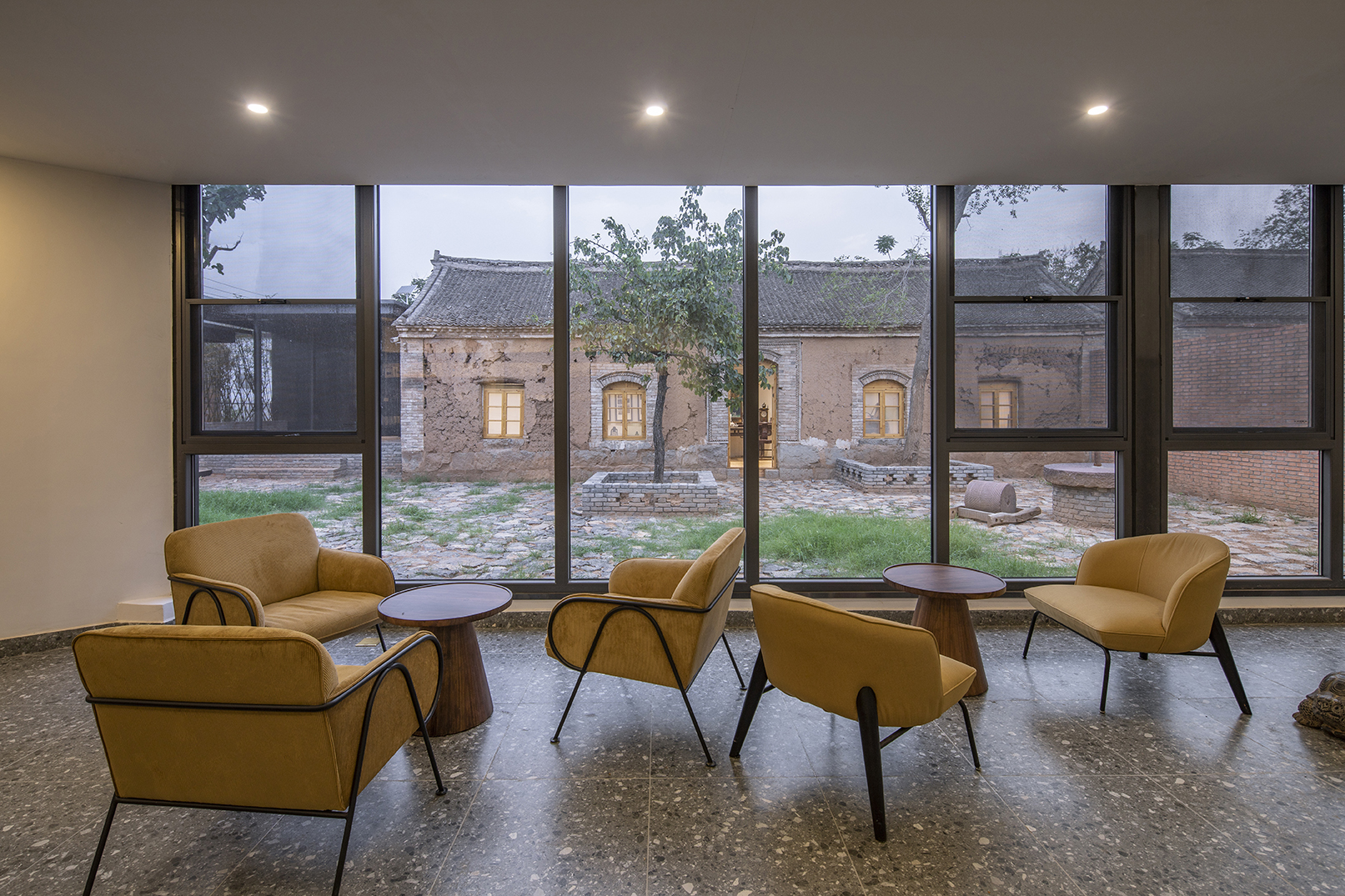
“椿暖花开”是一个景观性的艺术装置,依托村庄原有的一颗椿树创作完成。椿树位于规划的L形精品线路拐弯处,是南北主路景观的起点。装置的含义代表了改革开放的开始,春归大地,万物复苏。
The Spring Blossoms are a landscape art device, which is completed by the original Chinese toon tree in the village. The Chinese toon is located at the corner of the planned L-shaped boutique route, which is the starting point of the landscape of the north-south main street. The meaning of the device represents the beginning of Reform and Opening-up: spring returns to the earth, and everything recovers.

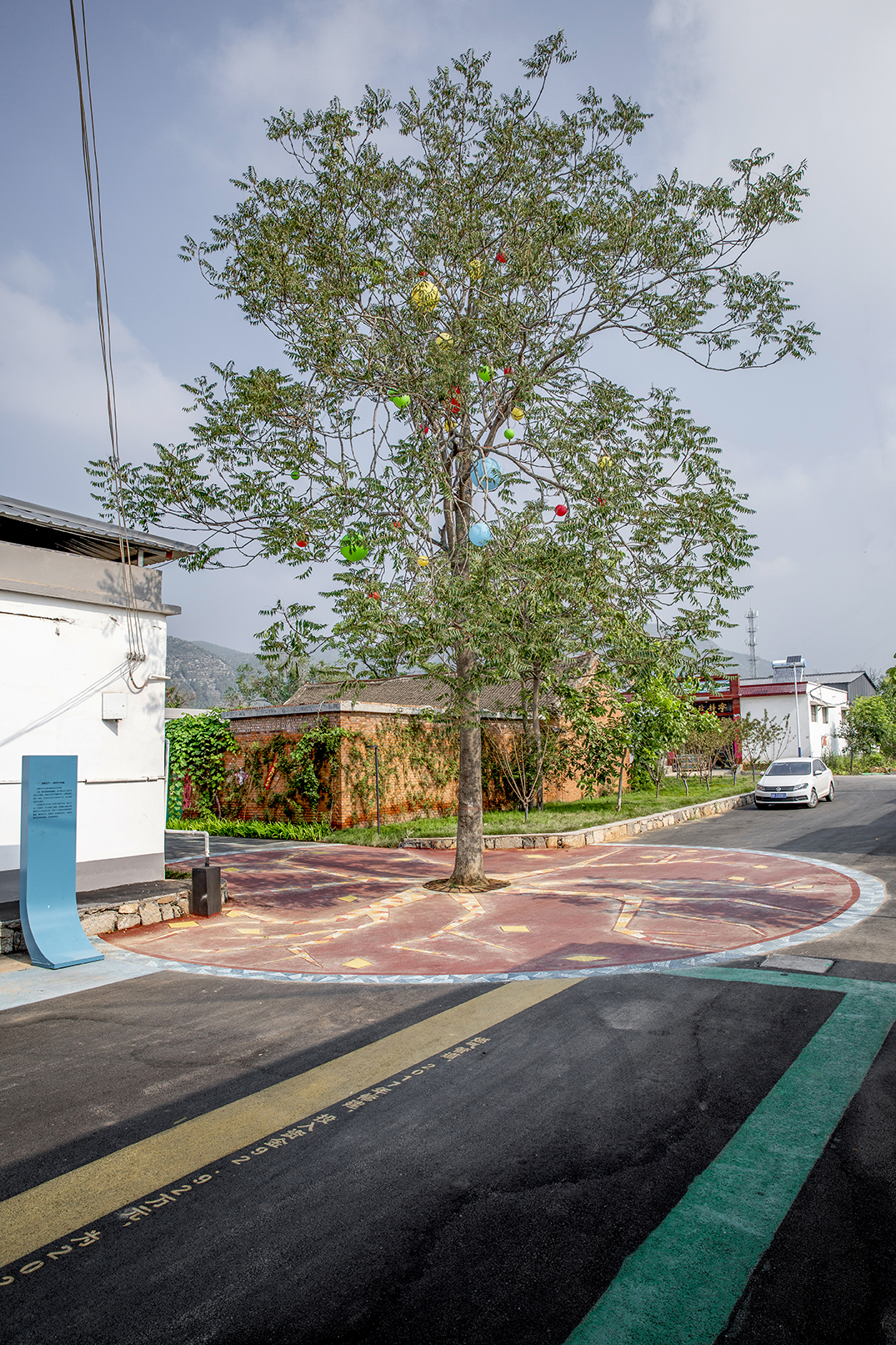

“有囍有鱼”广场,位于主街中部,场地原是集体用地,村民在此处种菜。菜地与道路间有一处变电站和一个杂货亭。建筑师将此处改造为村中的小广场,供村民日常休闲使用。
The Square of Double Happiness and Pisces is located in the middle of the main street, which was originally collective land where villagers planted vegetables. There is a substation and a grocery booth between the vegetable field and the streets. The architect transformed this place into a small square in the village for villagers' daily leisure use.


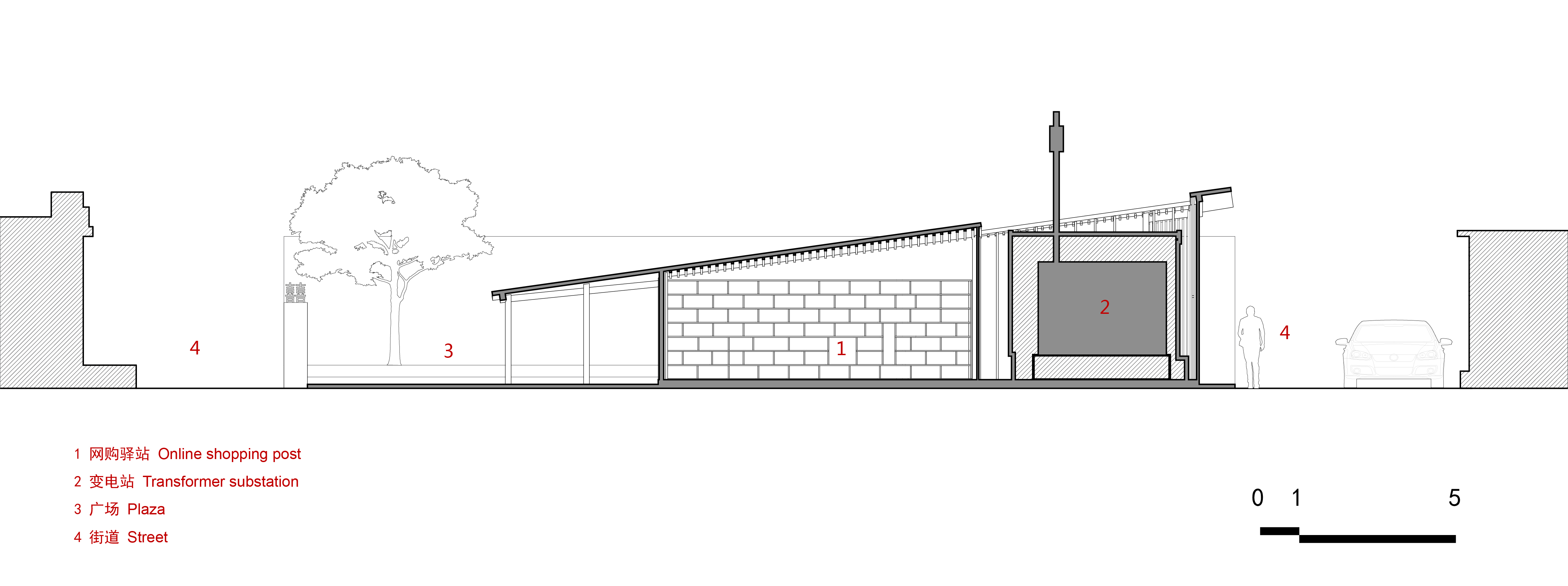
设计首先对场地硬化,使其更符合广场的功能,然后在广场一角增加布告栏,另一角增设了休息平台。广场和主街之间增建一处便民服务点,用于接收快递和小卖部。场地中原有的变电站无法搬迁,建筑师将裸露的变电设施改为更安全的箱变并包入建筑中,与便民服务点合二为一。服务点建筑平面成梯形,采用木结构和单坡顶,屋顶西南角高,东北角低。建筑师利用屋顶的釉面瓦和立面组合出“囍”和双鱼图案,代表村民对生活的美好愿望。
First, the site is hardened to make it more suitable for the function of square, then a notice board is added at one corner of the square and a rest platform at the other corner. Between the square and the main street, a new convenience service point is built to receive express delivery and small sales department. The original substation in the site could not be relocated. The architect changed the exposed substation facilities into a safer box transformer and incorporated it into the building, which is integrated with the convenience service point. The service point is trapezoidal in plane, with wooden structure and single slope top. The southwest corner of the roof is higher and the northeast corner lower. The architect uses the glazed tiles and facade of the roof to combine the "Double Happiness" and the Pisces patterns, representing the villagers' good wishes for life.



结语
尝试为普通乡村提供一个空间提升样本
像宰湾村一样的村庄在修武县乃至中国都有大量的存在。它们没有特殊的景色,没有历史风貌,也没有显著的产业,就是普通村庄,普通人和普通生活。如何为它们设计,是每个从事乡村建设的建筑师都需要思考的命题。
Villages like Zaiwan Village exist in quantity in Xiuwu County and even in whole China. They have no special scenery, no historical features, no significant industries, namely just ordinary villages with ordinary people and ordinary life. How to design them is a proposition that every architect engages in rural construction needs to think about.
在宰湾村,设计团队幸运地找到了改革开放40年豫北民居活态博物馆的主题,在保留村庄原有肌理、真实乡村景观和自发建造痕迹的基础上,以建筑、景观、公共艺术和叙事的方式加以串联、放大和诠释。这是一种偷巧,也是一种机巧,希望它能为中国此类普通村庄的振兴提供参考。
In Zaiwan Village, the design team was fortunate to find the theme of the Museum of Living Style of the North Henan Folk Residence of the Past 40 Years Since the Reform and Opening-up. On the basis of retaining the original texture, real rural landscape and spontaneous construction traces, the design team connected, enlarged and interpreted the village in the way of architecture, landscape, public art and narration. It is a kind of sneaking and also a kind of ingenuity. I hope it can provide reference for the revitalization of such ordinary villages in China.
完整项目信息
项目地点:河南省焦作市修武县七贤镇
业主:修武县七贤镇人民政府
建筑及景观设计:三文建筑
主创建筑师:何崴
项目建筑师:刘明阳
设计团队:陈龙、孟祥婷、王梓亦、刘咏、赵冬雨(实习)、王晨羽(实习)、陈明旭(实习)
驻场工程师:刘卫东
合作单位:北京华巨建筑规划设计院有限公司,北京鸿尚国际设计有限公司
设计时间:2020年11月—2021年1月
完成时间:2021年5月
摄影:金伟琦、何崴
景观规划设计面积:8.5公顷
豫北民居展厅建筑面积:820平方米
便民服务点建筑面积:108平方米
版权声明:本文由三文建筑授权发布。欢迎转发,禁止以有方编辑版本转载。
投稿邮箱:media@archiposition.com
上一篇:云中漫步:朵云书院黄岩店 / Wutopia Lab
下一篇:20万奖金+学生专属:中山华侨城欢乐海岸中心绿轴公共空间设计竞赛报名开放!